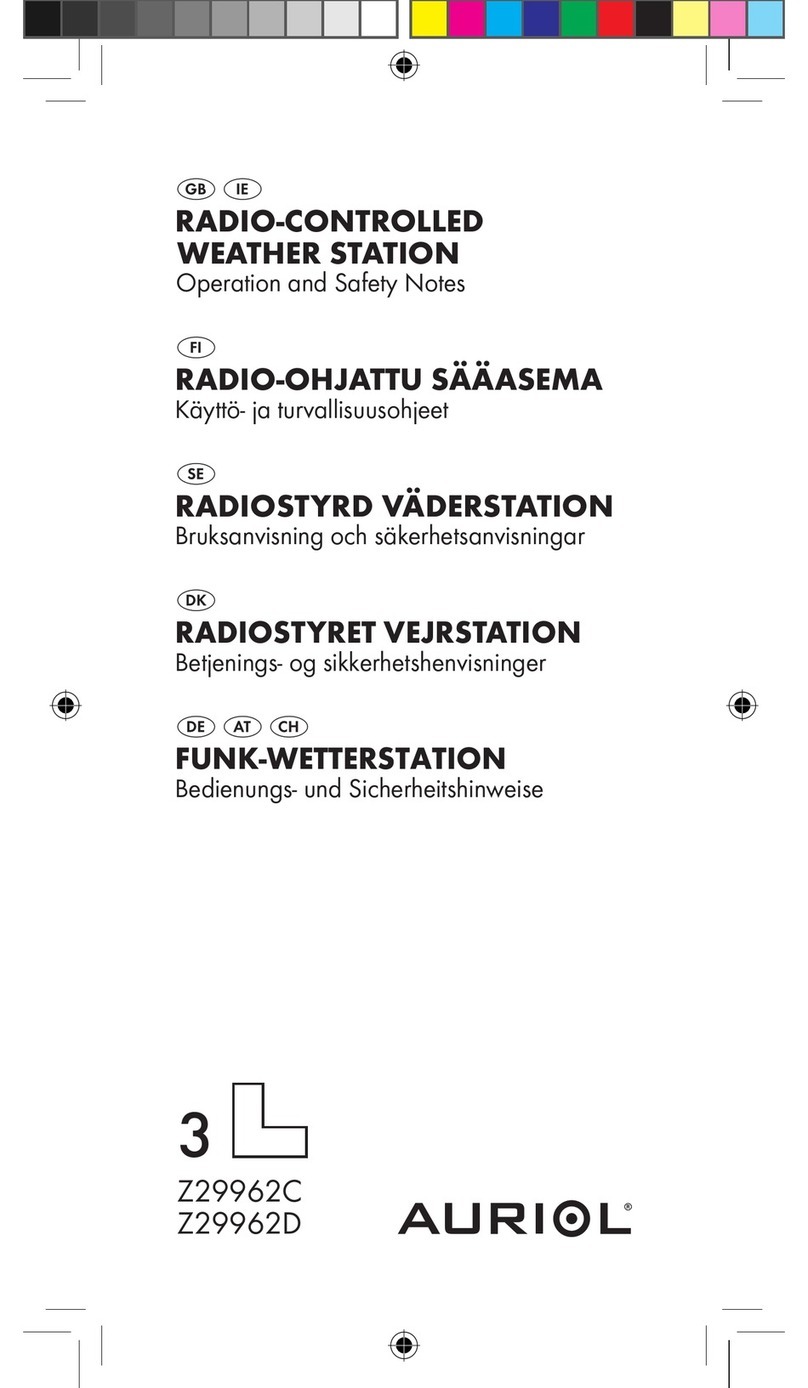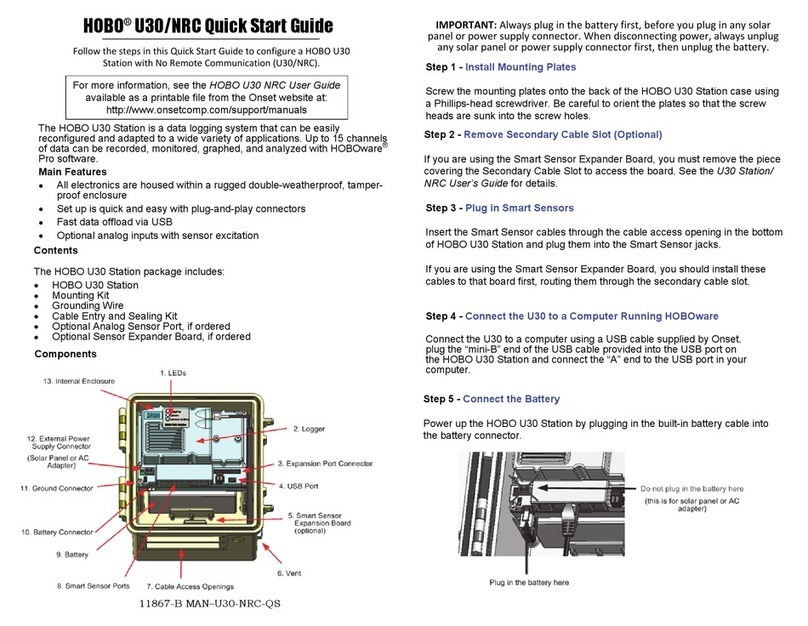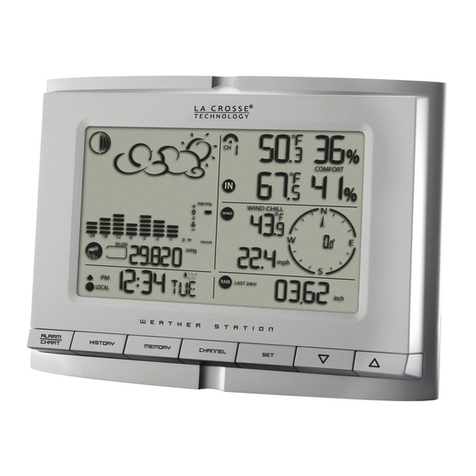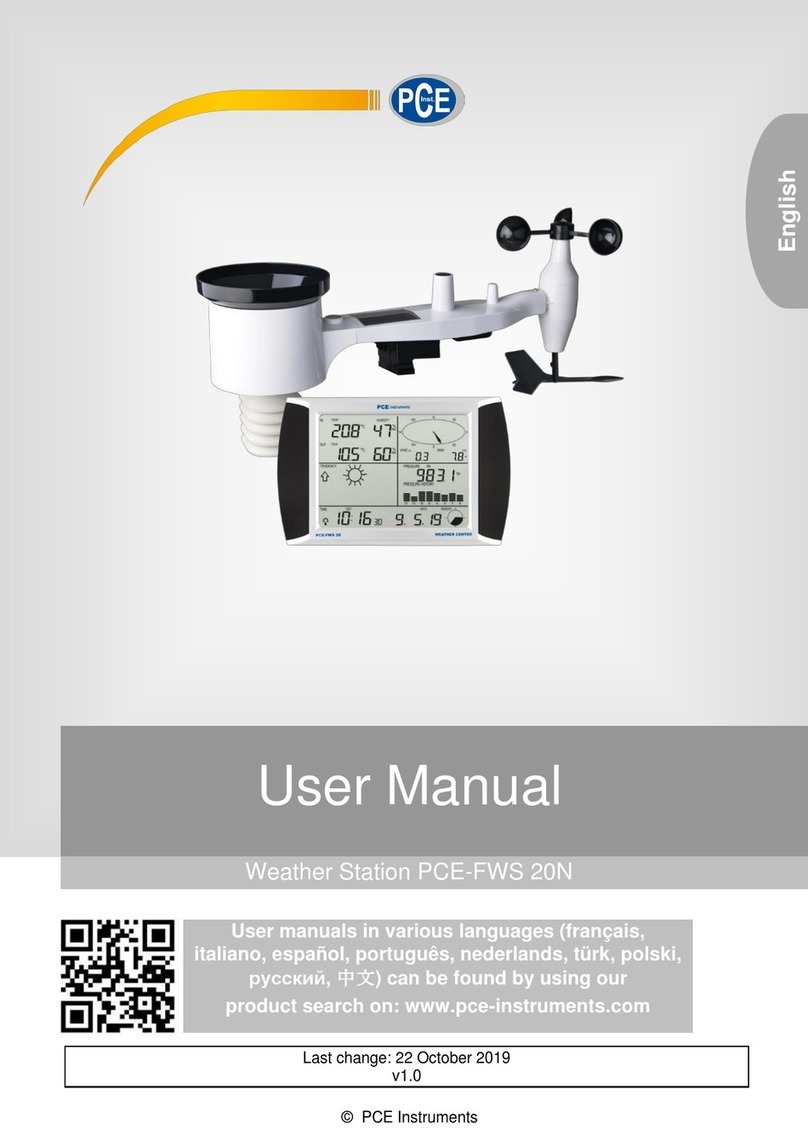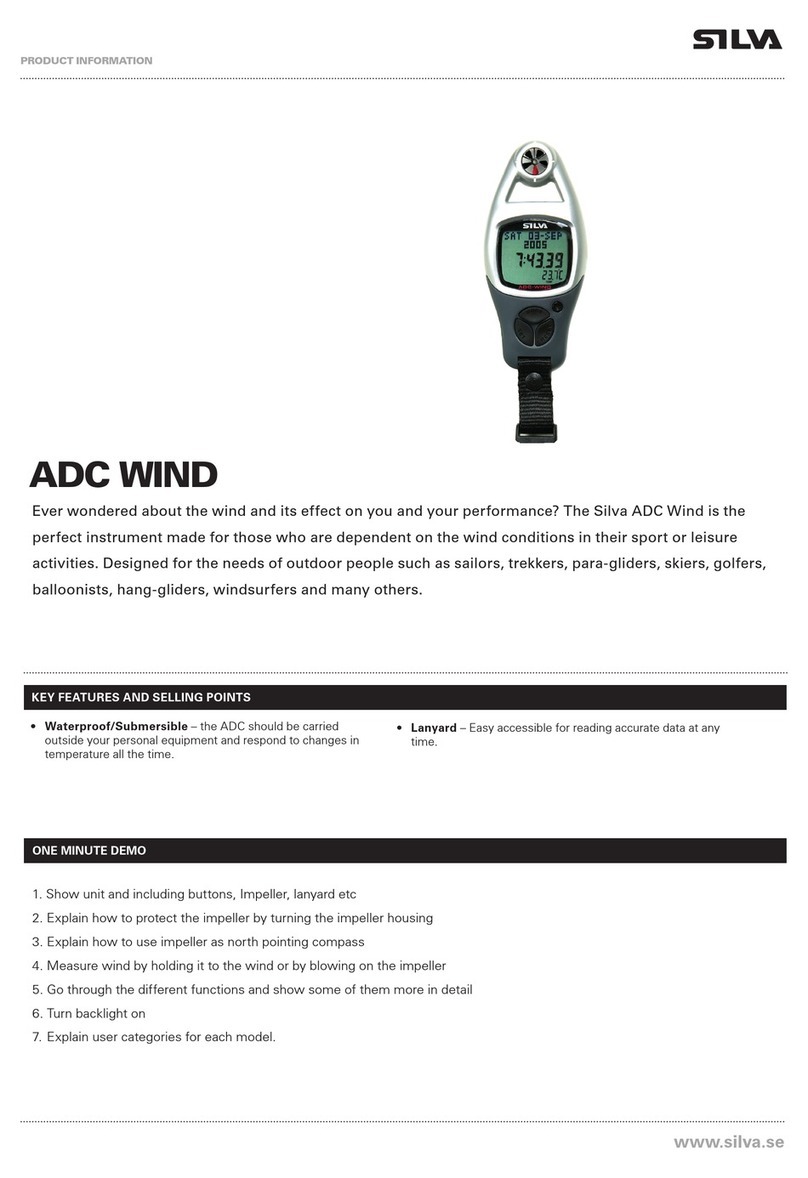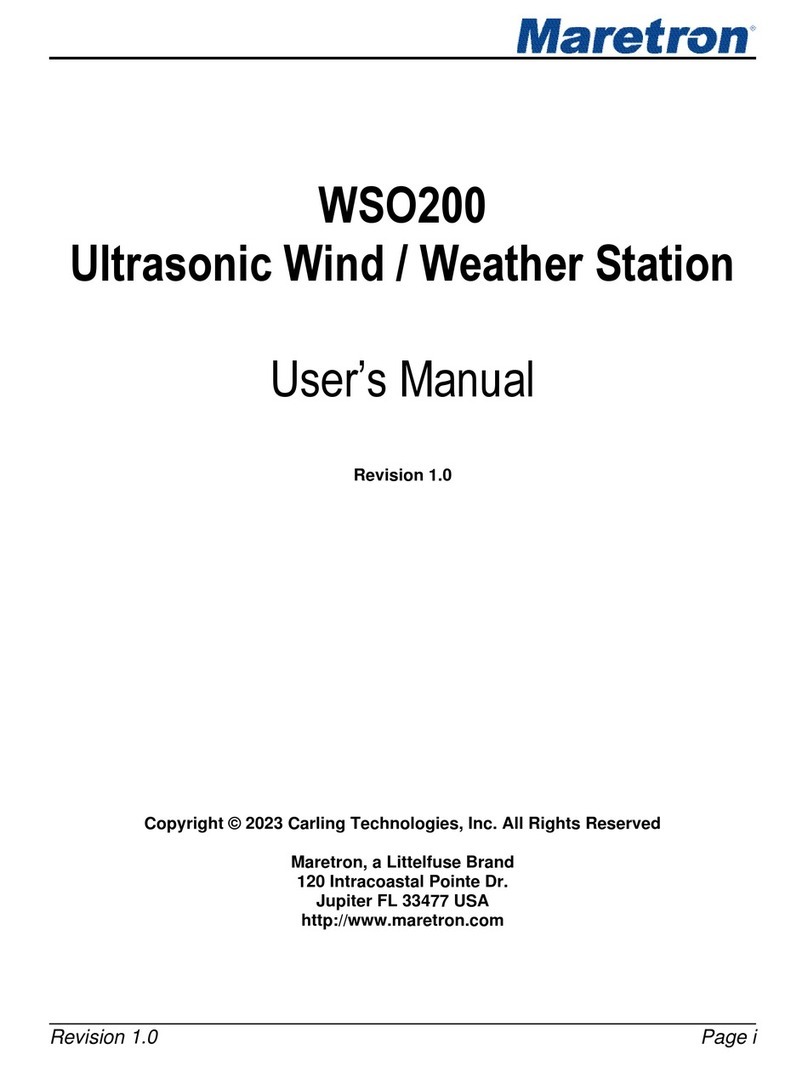Eschenbach Optik 53134 User manual

WIRELESS WEATHER STATION
Instruction manual
Introduction:
Congratulations on purchasing this state-of-the-arts Weather Station with radio-controlled time as an
example of fine design and quality piece of engineering. The operation of this product is easy and
straightforward. By reading this operating manual, users will receive a better understanding of the
Weather Station together with the optimum benefit of all its features.
Weather Station
•Radio controlled time with manual setting option.
•12/24 hour time display
•Calendar display
•Time zone selectable (±12 hours)
•Moon phases display
•Degree Celsius or Fahrenheit temperature selectable
•Current indoor temperature display
•Simultaneous minimum and maximum indoor temperatu re recordings
•Current relative indoor humidity display with "☺" Smiling or "L" Sad face for comfort level
reading
•3 weather icons for weather forecasting
•Weather tendency indicator
•Current outdoor temperature display
•Simultaneous minimum and maximum outdoor temperature recordings
•Current relative outdoor humidity display
•Manual minimum and maximum temperature recording resets
•LCD contrast changeable to 8 different tones
•Can take up to 3 outdoor transmitters
•Low battery indicator
•Wall mounting
Thermo-hygro Transmitter:
•Remote transmission of outdoor
temperature and humidity to weather
station by 433 MHz signals
•Rain proof casing
•Wall mounting case
Setting up:
1. First, insert the batteries into the Weather station (see How to install and replace the
batteries in the weather station below). Once the batteries are in place, all segments of the
LCD will light up briefly, then the indoor temperature and humidity, the time as “-:--“, the date as
“------“ , the Moon phase and the weather icons sun and clouds will be displayed. If the indoor
temperature and humidity are not displayed after a few seconds, remove the batteries and wait
for at least 10 seconds before reinserting them. Once the indoor data is displayed proceed to
step 2.
2. Within 3 minutes of activating the Weather station, place the batteries into the transmitter (see
How to install and replace the batteries in the Thermo-hygro transmitter below).
3. After inserting the batteries into the transmitter, the Weather station will start receiving data from
the transmitter. The outdoor temperature and humidity should then be displayed on the Weather
station. If this does not happen after 10 minutes, the batteries will need to be removed from
both units and reset from step 1.
4. The Weather station can take up to 3 remote transmitters. If you have purchased additional
transmitters, follow step 2 for all extra transmitters. However, ensure that you leave 10 seconds
in between the reception of the last transmitter and the set-up of the following transmitter. The
Weather station will number the transmitters in the order of set-up, i.e. the first transmitter will
have the temperature displayed with the number 1 against it and so on.
5. When all the transmitters are set up, there is a testing period, during which the display switches
quickly between all the received transmitters at random, according to which random
transmission it receives. Pressing any key will stop this process and the display will show the
temperature and humidity for the first transmitter. The process also stops automatically if no
keys are pressed for a few minutes.
6. Once the remote temperature has been received and displayed on the Weather station, the
DCF-77 time code reception is automatically started. This takes typically between 3-5 minutes
in good conditions. This time period is an excellent opportunity to locate the transmitter(s) in
suitable location(s) outdoors. In order to ensure sufficient 433 MHz transmission however, this
should under good conditions be no more than 20 - 25 meters from where the Weather station
will be finally positioned (see notes on “Positioning” and “433 MHz Reception”).
7. If after 10 minutes, the DCF time has not been received, use the SET key to manually enter a
time initially. The clock will then automatically attempt a new reception the next full hour or as
long as one DCF reception is successful. When this is successful, the received time will
override the manually set time. The date is also updated with the received time. Also a radio
reception always take place between 00:00 am and 06:00 am each day (attempts DCF
reception every full hour within this time framer. Please refers to notes on “Radio controlled
time” and “Manual time setting”).
Hanging hole
LCD display
CHANNEL key
RESET key
SET key
+key

How to install and replace the batteries in the Weather station
The Weather station uses 2 x AA, IEC LR6, 1.5V batteries. When
batteries will need to be replaced, the battery symbol will appear on the
LCD.
To install and replace the batteries, please follow the steps below:
1. Insert finger or other solid object in the space at the bottom
center of the battery compartment and lift up to remove the
cover.
2. Insert batteries observing the correct polarity (see marking).
3. Replace compartment cover.
How to install and replace the batteries in the Thermo-Hygro transmitter
The Thermo-Hygro transmitter uses 2 x AA, IEC LR6, 1.5V batteries. To install
and replace the batteries, please follow the steps below:
1. Remove the battery cover.
2. Insert the batteries, observing the correct polarity (see marking).
3. Replace the battery cover on the unit.
Note:
In the event of changing batteries in any of the units, all units need to be reset by following the setting
up procedures. This is because a random security code is assigned by the transmitter at start-up and
this code must be received and stored by the Weather station in the first 3 minutes of power being
supplied to it
Replacing batteries:
For best performance, when the low battery appears on the LCD screen of the Weather station or
when contrast becomes dim and unclear on the LCD, batteries should be replaced to both units at
least once a year to maintain maximum running accuracy.
Please help in the preservation of the environment and return used batteries to an
authorized depot.
FUNCTION KEYS:
Weather station:
The weather station has four easy to use function keys, 2 on the front side and 2 at the back:
SET key
•Used to enter the set mode for the following functions: 12/24 hour display, Time, Time zone,
Weekday, Month, Date, Year, ºC/ºF, and LCD contrast
CHANNEL key
•Used to toggle between the outdoor Thermo-Hygro transmitters 1, 2 and 3.
•Used to exit the manual setting mode
+ key
•Used to changes the values in manual setting modes
RESET key
•Used to reset all indoor temperatures, and the selected outdoor transmitter temperatures
•Used to exit the manual setting mode
LCD Screen
After inserting the batteries, all the segments on the LCD will light up briefly before displaying the time
and all the other modes
Radio-controlled time
The time base for the radio-controlled time is a Cesium Atomic Clock operated by the Physikalisch
Technische Bundesanstalt Braunschweig which has a time deviation of less than one second in one
million years. The time is coded and transmitted from Mainflingen near Frankfurt via frequency signal
DCF-77 (77.5 kHz) and has a transmitting range of approximately 1,500 km. Your radio-controlled
Weather Station receives this signal and converts it to show the precise time in summer or wintertime.
The quality of the reception depends greatly on the geographic location. In normal cases, there
should be no reception problems within a 1,500km radius around Frankfurt.
Once the outdoor temperature is displayed on the Weather station, the DCF tower icon in the clock
display will start flashing in the upper center in the time section. This indicates that the clock has
detected that there is a radio signal present and is trying to receive it. When the time code is
received, the DCF tower becomes permanently lit and the time will be displayed.
If the tower icon flashes, but does not set the time or the DCF tower does not appear at all, then
please take note of the following:
DCF tower reception icon
Time display
Weekday display Date display
Moon phase display
Current indoor
temperature display
Minimum indoor
temperature display
Maximum indoor
temperature display
Comfort indicator icon Indoor relative humidity
display in RH%
Weather tendency
indicator
Weather forecast icon
Current outdoor
temperature display
Minimum outdoor
temperature display Maximum outdoor
temperature display
Outdoor relative humidity
display in RH%
Outdoor transmitter identification
Outdoor transmission signal

Date
(flashing)
Weekday
(flashing)
•Recommended distance to any interfering sources like computer monitors or TV sets is a
minimum of 1.5 - 2 meters.
•Within ferro-concrete rooms (basements, superstructures), the received signal is naturally
weakened. In extreme cases, please place the unit close to a window and/or point its front or
back towards the Frankfurt transmitter.
•During night time, the atmospheric disturbances are usually less severe and reception is
possible in most cases. A single daily reception is adequate to keep the accuracy deviation
below 1 second.
Manual setting
When pressing the SET key, the following manual setting can be changed:
•12/24 hour time display
•Time setting
•Time zone setting (±12 hours)
•Weekday setting
•Month setting
•Date setting
•Year setting
•ºC/ºF temperature setting
•LCD contrast setting
12/24 hour display setting
1. The “12”or “24” will be flashing (Default setting 24). Choose the desired time display mode by
use of the +key.
2. Press the SET key to enter the Time Setting mode.
Note:
If 12 hour time display has been selected, the calendar will be: weekday, month and date.
If 24 hour time display has been selected, the calendar will display: weekday, date, and month.
Time setting
1. The hour digits will start flashing. Set the desired hours by pressing the +key followed by
pressing the SET key.
2. Now the minute digits will start flashing. Set the desired minutes by pressing the +key
3. Press again the SET key to enter the Time Zone Setting mode.
Note:
If the DCF-77 time signal is already received by the Weather Station and is correctly displayed, then
the time setting can be omitted.
Time Zone Setting
1. The display “Zo 0” will start flashing (Default setting “0h”). The time zone can be set ±12 hours
2. Use of the +key to select the required time zone.
2. Press the SET key to enter to the Date setting mode.
Date Setting
If the DCF-77 time signal is already received by the Weather Station and is correctly displayed, then
the date setting can be omitted.
1. The weekday digits will start flashing (weekday will only be displayed in German). Select the
desired weekday by pressing the +key.
2. Press the SET key. The month will now start flashing.
3. Select the desired month by pressing the +key.
4. Press the SET key. The day starts flashing.
5. Select the day with the +key.
6. Press the SET key to select the year. The year will start flashing.
7. Select the year with the + key. A range from 2000 through 2020 can be chosen
8. Press again the SET key to enter the “Temperature setting in °C/°F” mode.
Note:
The Moon phase will be displayed accordingly to the date setting.
Temperature setting in °C/°F
1. All indoor/outdoor, minimum and maximum temperature values will start flashing (Default
setting in “ºC”). Using the +key, select the temperatures to be displayed in degrees Celsius or
in degrees Fahrenheit.
2. Press the SET key to enter the LCD contrast setting mode.
Important note:
The temperature icons “ºC” or “ºF” will not be displayed with the temperature values. Only the
temperature values will be displayed and will toggle accordingly to the setting.
When toggling between the two settings, if lower temperature values are displayed in the both indoor
and outdoor temperature sections, it means the temperature setting has been set in degree Celsius. If
higher temperature values are displayed in both the indoor and outdoor temperature sections, it
means the temperature setting has been set in degree Fahrenheit.
LCD contrast setting
1. The digit “LCD 5” will start flashing (default setting). Use the + key to select the required
contrast from 0-7 level.
2. Press the SET key to exit the manual setting mode
Minimum and maximum indoor temperature recordings:
Underneath the current indoor temperature reading are the minimum and maximum indoor
temperature recordings. These are simultaneously displayed for constant and easy reading. This
feature is useful for displaying the recorded temperatures of the room which the Weather Station has
been placed. When a new temperature low or high is reached, it will be automatically updated and
displayed.
“24h” (flashing)
Time zone (flashing)
Flashing
Hour (flashing) Minutes (flashing)
Year
(flashing)

Indoor relative humidity with comfort level reading (face icons) and Outdoor
relative humidity reading
The indoor relative humidity with comfort level reading and the outdoor relative humidity reading are
displayed respectively underneath the indoor and outdoor temperatures. With the comfort level
feature, users can determine how comfortable the indoor relative humidity is within their current
surroundings. Again, as with the indoor temperature, the indoor relative humidity reading will
automatically be taken once the batteries are inserted into the Weather station. The indoor relative
humidity is updated every minute.
Once the batteries are inserted into the Thermo-Hygro transmitter, the Weather Station will also start
receiving data from the transmitter. The outdoor relative humidity will then be displayed and will be
updated every 5 minutes.
Working together with relative humidity, the Weather Station will register a comfort level reading by
representation of a "☺" Happy" or "L" Sad face. The temperature range between +20ºC to +25.9ºC
(+68ºC to +79ºC) and relative humidity range between 45% to 66% will register the "Happy" face. The
"Sad" face will appear should either the temperature or humidity readings be outside these set
ranges. This means, the "Happy" face represents a comfortable level and the "Sad" face represents
an uncomfortable one.
When the "L" "Sad" face appears with the word "DRY" or "WET", it means that the relative humidity
reading is outside its comfort level range. However, "DRY" or "WET" will not appear if only the
temperature reading is outside its comfort level range. The "L" "Sad" face and "Dry" will appear if the
relative humidity level is below 44% or "WET" will appear if the level is above 67%.
Weather tendency icons
There are 3 weather icons on the LCD which can be displayed in any one of the following
combinations:
Sunny Cloudy with sunny intervals Rainy
For every sudden or significant change in the air pressure, the weather icons will update accordingly
to represent the change in weather. If the icons do not change, then it means either the air pressure
has not changed or the change has been too slow for the Weather Station to register. However, if the
icons displayed is a sun or raining cloud, there will be no change of icon if the weather gets any better
(with sunny icon) or worse (with rainy icon) since the icons are already at their extremes.
The icons displayed forecasts the weather in to terms of getting better or worse and not necessarily
sunny or rainy as each icon indicates. For example, if the current weather is cloudy and the rainy icon
is displayed, it does not mean that the product is faulty because it is not raining, it simply means that
the air pressure has dropped and the weather is expected to get worse but not necessarily rain.
Note:
After setting up, readings for weather forecasts should be discarded for the next 12-24 hours. This will
allow sufficient time for the Weather Station to operate at a constant altitude and therefore result in a
more accurate forecast.
Common to weather forecasting, absolute accuracy cannot be guaranteed. The weather forecasting
feature is estimated to have an accuracy level of about 75% due to the varying areas the Weather
Station has been designed for use in. In areas that experience sudden changes in weather (for
example from sunny to rain), the Weather Station will be more accurate compared to use in areas
where the weather is stagnant most of the time (for example mostly sunny).
If the Weather Station is moved to another location significantly higher or lower than its initial standing
point (for example from the ground floor or the first floor of a house), remove the batteries and re-
insert them after about 30 seconds. By doing this, the Weather Station will not mistake the new
location as being a possible change in air-pressure when really it is due to the slight change of
altitude. Again, discard weather forecasts for the next 12 to 24 hours as this will allow time for
operation at a constant altitude.
The weather tendency indictor
The weather tendency arrows are located above and below the weather icons and indicate the
change in air-pressure and thus, forecasts the expected weather.
The tendency arrows can be displayed as follows:-
•Tendency arrow pointing upwards:
This means that the air-pressure is increasing and so the weather is expected to improve.
•Tendency arrow pointing downwards:
This means that the air-pressure is decreasing and the weather is expected to become worse.
Taking this into account, the unit can also show how the weather has changed and is expected to
change. For example if the arrow pointing downwards is displayed together with cloud and sun
weather icons, then the last noticeable change in the weather was when it was sunny (the sun icon
only was shown). This means that the next change in the weather will be rainy icons since the
tendency arrow is pointing downwards.
Note:
The weather tendency indictor arrows remain on the LCD regardless of the current weather. For
example, if the current weather is raining, and the arrow is pointing downwards, it means that the
weather will remain poor and if the weather is sunny and the arrow is pointing upwards, it means that
the weather is expected to remain fine.
Outdoor Temperature Reading:
The outdoor temperature is displayed underneath the weather icons section. The Weather Station
will automatically start scanning transmitter's 433 MHz signal after the batteries are inserted and once
received, the outdoor temperature will appear on the LCD.
Minimum and maximum outdoor temperature recordings:
On the bottom line of the LCD are the outdoor minimum and maximum temperature recordings.
These are simultaneously displayed for a constant update and easy reading. When a new
temperature low or high is reached, it will be updated and recorded into the Weather Station’s
memory.
Resetting minimum and maximum indoor and outdoor temperatures
The minimum and maximum indoor and outdoor temperature can be reset by pressing the RESET
key for 3 seconds. Once the RESET key is pressed, all indoor and the selected outdoor data will
update to the current.
Note:
When resetting the minimum and maximum outdoor temperatures, the data from the selected
transmitter will only be reset. The minimum and maximum outdoor temperatures from the other
outdoor transmitters will not be reset. Each outdoor data have to be reset separately.
Thermo-Hygro transmitter:
The temperature and humidity are measured every 1 minute and transmitted every 5 minutes.

The range of the Thermo-Hygro transmitter may be affected by the temperature. At cold temperatures
the transmitting distance may be decreased. Please bear this in mind when placing the transmitter.
Checking for 433 MHz reception:
The same as the DCF-77 signal, the Weather Station will automatically start scanning for the 433
MHz signal after the batteries are inserted. If the outdoor temperature is not displayed after about 30
seconds, then check the following list before resetting the units (see Resetting below):
1. The distance of the Weather Station should be at least 1.5 - 2.0 meters away from interfering
sources such as computer monitors or TV sets.
2. Avoid placing the units onto or in the immediate proximity of metal window frames.
3. Using other electrical products such as headphones and speakers that operate on the same
frequency signal (433 MHz) may prevent the transmission pick up.
4. Neighbours using electrical items operating on the 433 MHz signal can also cause interference.
Note:
When the 433 MHz signal for the outdoor temperature has been received, do not re-open the battery
cover to either the Weather Station or transmitter as the batteries may accidentally spring free from
the contacts and force a false reset. Should this happen then reset both units (see Resetting below)
otherwise transmission problems may occur.
The transmission range from the temperature transmitter to the Weather Station (433 MHz) is up to
25 meters in open space, but again this depends on the surrounding environment and interference
levels. If reception is still not possible, then reset both units (see Resetting below).
The transmitter's transmitting range may be affected by exposure to extreme cold conditions (-25ºC)
for long periods of time. Should this happen, the 433 MHz signal may be weakened and therefore
result in shorter transmitting distances. The contrast of the LCD may reduce due to the power
reduction of the batteries caused by such sub-zero temperature levels.
Resetting:
1. Remove batteries from both the Weather Station and the transmitter
2. Wait at least 30 seconds and then repeat the procedures specified in Setting up (above).
Note:
Always wait at least 30 seconds after removing the batteries before reinserting, otherwise start up
and transmission problems may occur.
Positioning the Weather Station:
Before wall mounting, please check that the outdoor temperature can be received
from the desired locations. To wall mount:
1. Fix a screw (not supplied) into the desired wall, leaving the head
extended out the by about 5mm.
2. Hang the station onto the screw. Remember to ensure that it
locks into place before releasing.
Positioning the Thermo-Hygro transmitter
The Thermo-Hygro transmitter is supplied with two screws for wall mounting. Before securing the
transmitter, ensure that the 433MHz signal (outdoor temperature and relative humidity readings) is
properly received.
The mounting surface can affect the transmission
range. If e.g. the unit is attached to a piece of metal, it
may then either reduce or increase the transmitting
range. For this reason, we recommend not placing
the unit on any metal surfaces or in any position
where a large metal or highly polished surface is in
the immediate proximity (garage doors, double
glazing etc.). Before securing in place, please ensure
that the Weather station can receive the signal from
the Thermo-Hygro transmitter at the positions that
you wish to situate them.
Care and Maintenance:
•Extreme temperatures, vibration and shock should be avoided as these may cause damage to
the units and give inaccurate forecasts and readings.
•When cleaning the display and casings, use a soft damp cloth only. Do not use solvents or
scouring agents as they may mark the LCD and casings.
•Do not submerge the units in water.
•Immediately remove all low powered batteries to avoid leakage and damage. Replace only with
new batteries of the recommended type.
•Do make any repair attempts to the units. Return them to their original point of purchase for
repair by a qualified engineer. Opening and tampering with the units may invalidate their
guarantee.
•Do not expose the units to extreme and sudden temperature changes, this may lead to rapid
changes in forecasts and readings and thereby reduce their accuracy.
Specifications:
Recommended operating temperatures:
Weather Station : 0ºC to +50ºC
Transmitter : -29.9ºC to +59.9ºC
Temperature measuring range
Indoor : 0ºC to +60ºC with 0.1ºC resolution
+32ºF to +140ºF with 0.2ºF resolution
("OFL" displayed if outside this range)
Outdoor : -29.9ºC to +59.9ºC with 0.1ºC resolution
-21.8ºF to +139.8ºF with 0.2ºF resolution
("OFL" displayed if outside this range)
Relative indoor humidity range : 20% to 95% with 1% resolution
•if the indoor temperature is
outside the range “OFL” : Indoor relative humidity will display “- -“
•if the indoor relative humidity is
less than 20% or greater than 95% : Indoor relative humidity will display
19% or 96%
Relative outdoor humidity range : 20% or 95%
("- -" displayed if outside this range)
Temperature checking intervals
Indoor : 20 seconds
Outdoor : 5 minutes
Humidity checking interval
Indoor : 1 minute
Outdoor :5 minutes
Transmitter temperature reading update : 1 minute

Temperature transmitting range up to : 25 meters
Power source:
Weather Station : 2 x AA, IEC LR6 1.5V batteries
Transmitter : 2 x AA, IEC LR6 1.5V batteries
Battery life for both units : Approximately 12 months
(alkaline batteries recommended)
Dimensions (L x W x H):
Weather Station (excluding stand) : 163 x 31 x 450 mm
Thermo-Hygro transmitter : 60 x 73 x 121 mm
Liability Disclaimer
•The manufacturer and supplier cannot accept any responsibility for any incorrect readings and
any consequences that occur should an inaccurate reading take place.
•This product is not to be used for medical purposes or for public information.
•This product is designed for use in the home as indication of the future weather and is not 100%
accurate. Weather forecasts and barometric readings given by this product should be taken
only as an indication and not as being totally accurate.
•The specifications of this product may change without prior notice.
•This product is not a toy. Keep out of the reach of children.
•No part of this manual may be reproduced without written consent of the manufacturer.
R&TTE Directive 1999/5/EC
Summary of the Declaration of Conformity : We hereby declare that this wireless transmission device does comply
with the essential requirements of R&TTE Directive 1999/5/EC.
Table of contents
Popular Weather Station manuals by other brands
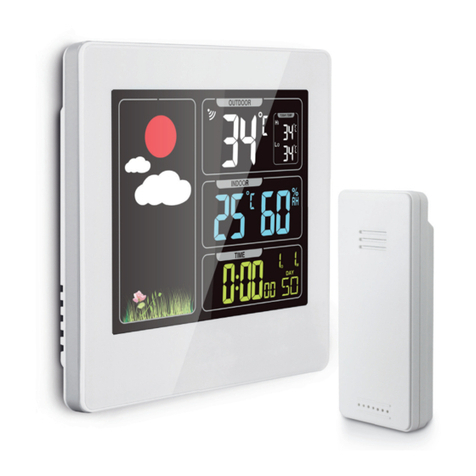
THOMSON
THOMSON 513630 manual

Oregon Scientific
Oregon Scientific RMS600A user manual
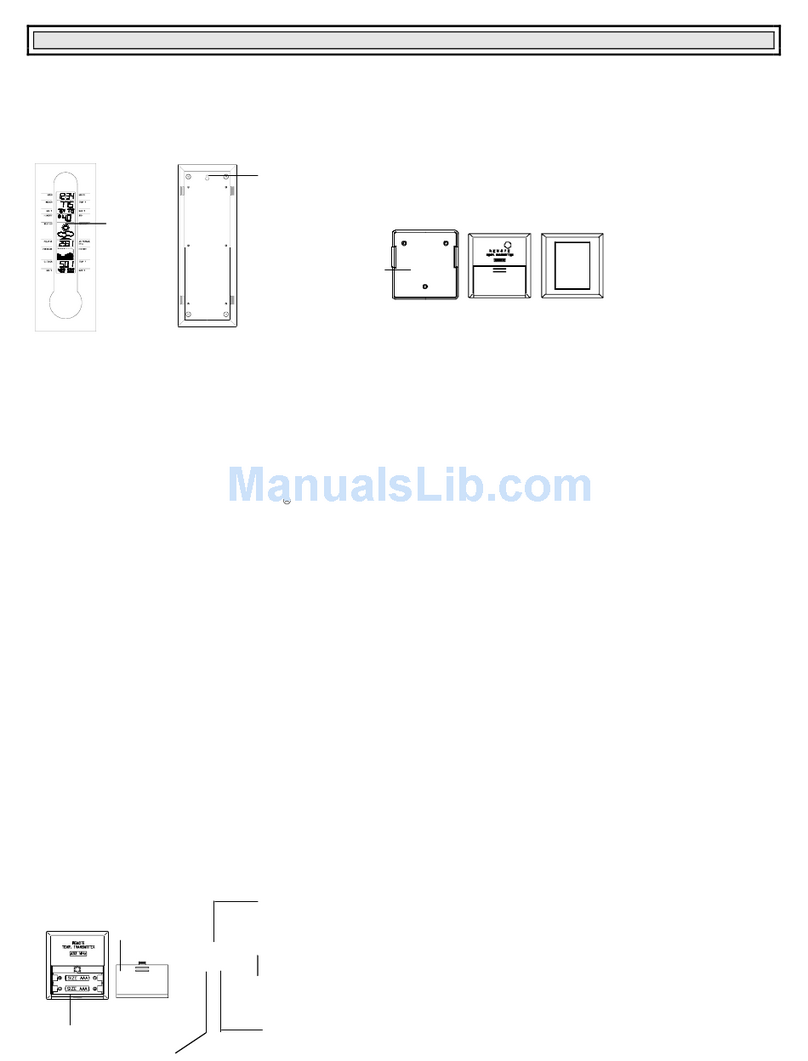
La Crosse Technology
La Crosse Technology WS-7090U instruction manual

Oregon Scientific
Oregon Scientific BA-116 instruction manual
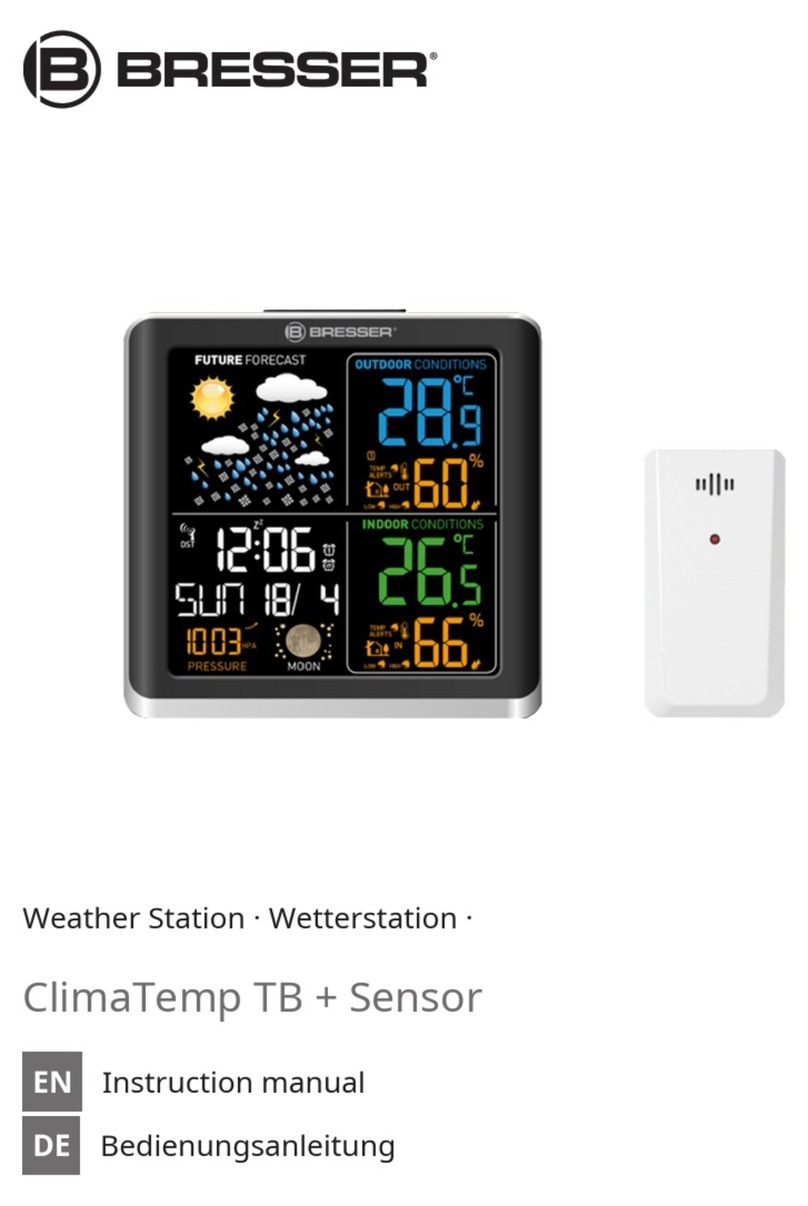
Bresser
Bresser 7007201 instruction manual

Duemmegi
Duemmegi Domino DFMETEO quick start guide
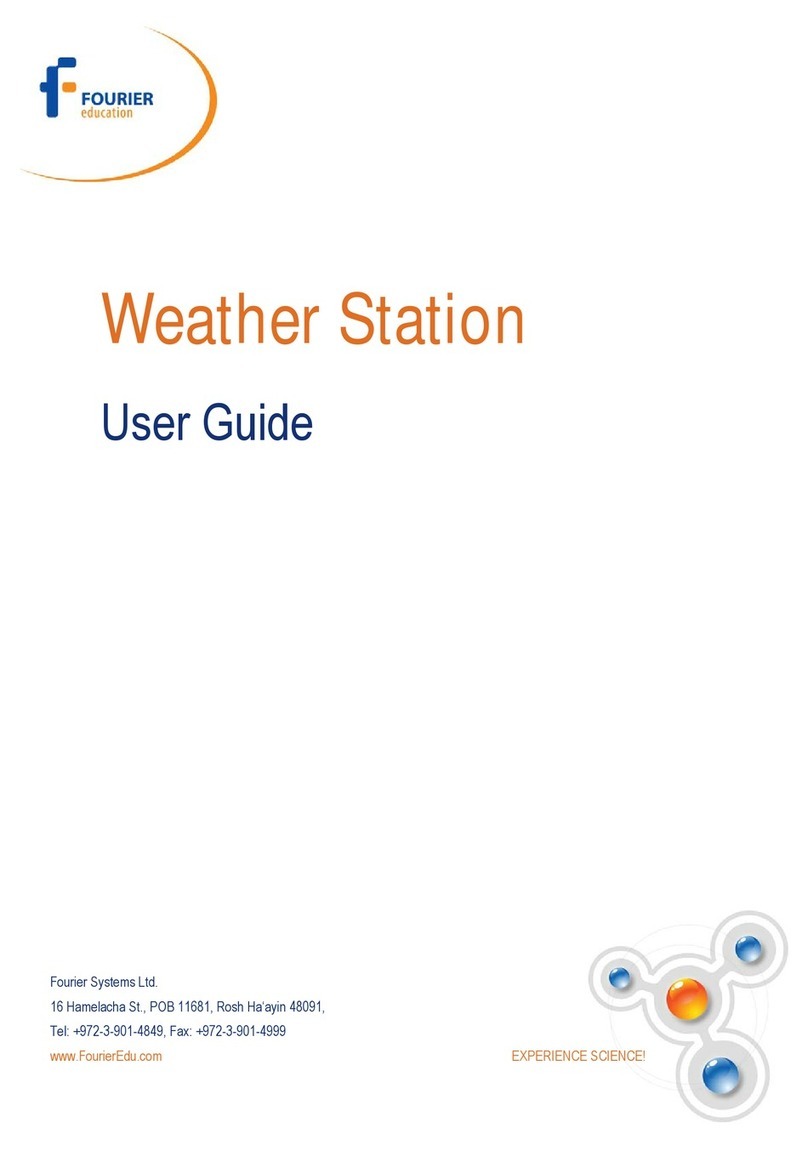
Fourier
Fourier MultiLogPRO user guide
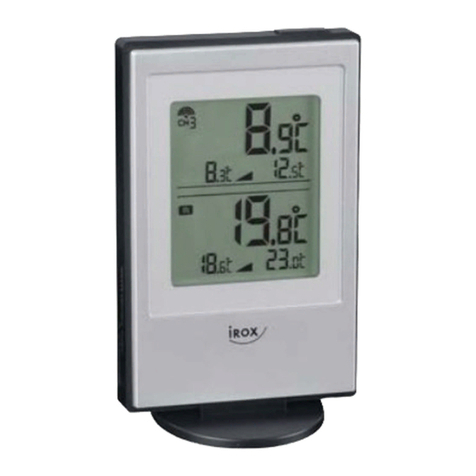
IROX
IROX JKT-3R operating instructions
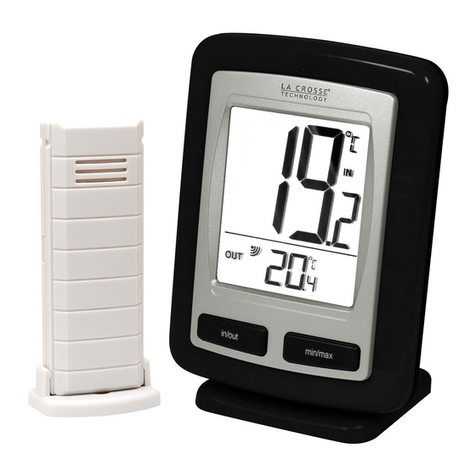
La Crosse Technology
La Crosse Technology WS-9009BK-IT Faqs
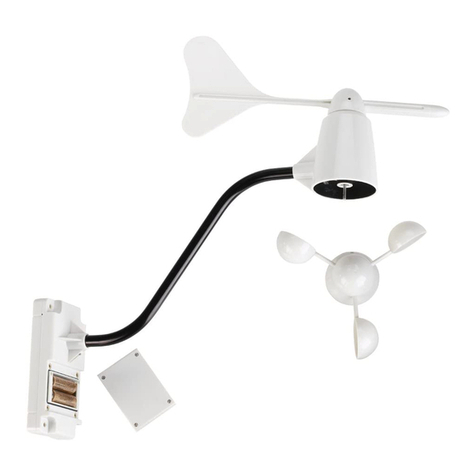
Honeywell
Honeywell TE923WD - Display Unit For Professional Weather Station... user manual
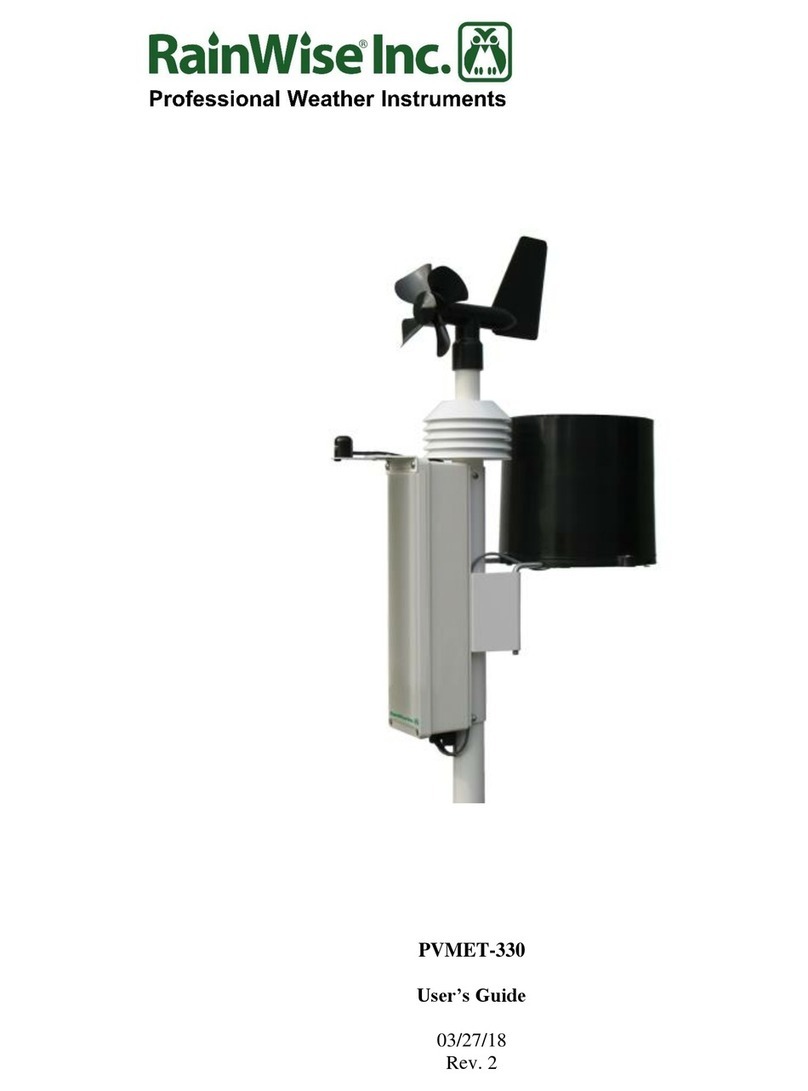
RainWise
RainWise PVMET-330 user guide

All Weather Inc
All Weather Inc AWOS 3000 Installation and checkout manual
